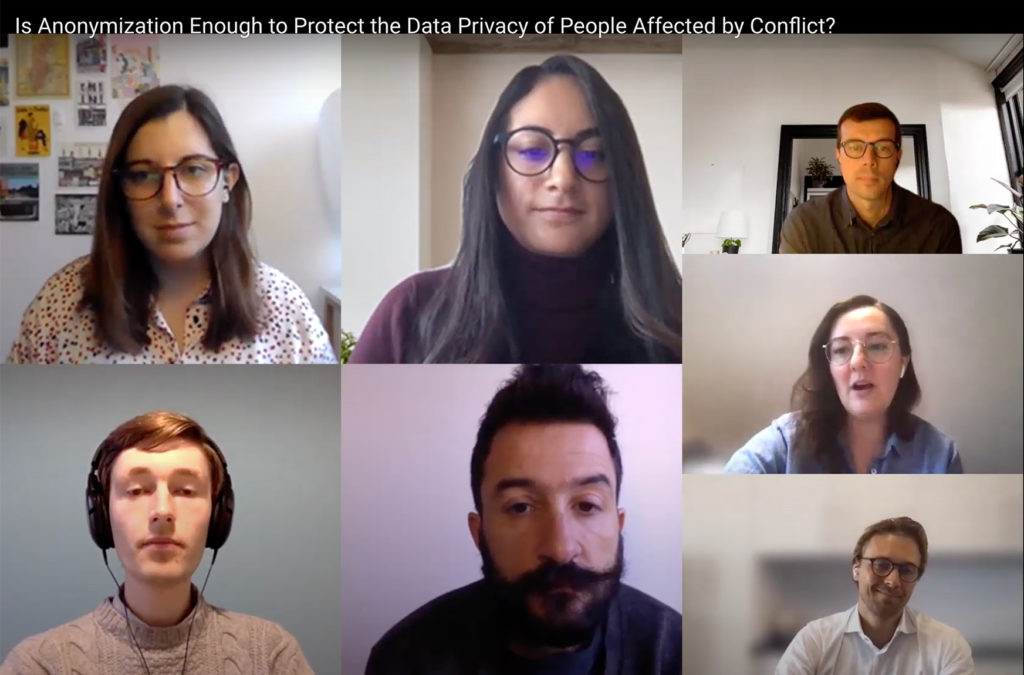How can we ensure the anonymity of people of concern in data-sharing processes while maintaining the value of datasets? Or, in other words, which tools and methods can we adopt to exchange confidential information in a safe and secure way?
These were some of the opening questions for the technical session and debate hosted by JIPS on November 30th during the 2021 ICRC Analysis & Evidence week, and co-paneled by data experts from UNHCR, UN OCHA’s Centre for Humanitarian Data, and Flowminder. Although data-sharing technology (and related technical jargon) may still look undecipherable to the majority of humanitarian practitioners, they are of paramount importance to protect affected people and deliver solutions tailored to their needs. Preventing re-identification is one of the core challenges in the sector. As Jos Berens, Data Policy Officer at the UN OCHA’s Centre for Humanitarian Data pointed out, some of the approaches to sharing data or insights while protecting individuals and groups, can be learned from National Statistical Offices (NSOs).
As explained by Sofia Sacks-Ferrari, UNHCR Regional Data Curator, “anonymisation is a tool to reach a level of risk we’re comfortable at, rather than an absolute standard. It’s never completely possible to prevent disclosure.” Moreover, Berens added that for very rich micro datasets – containing many variables – it becomes impossible to reduce the re-identification risk enough without losing value in the data. For some organisations, he explains, the solution might be to share ‘summary analysis’ or high-level aggregated findings, and to only make the full dataset available to specific users on request.
The conversation headed towards a key concept in sensitive operational contexts: data landscape mapping. “We need to start bringing datasets together and communicate, safely and responsibly, about what data is available in a given context” clarified Patrick Brock, Senior Data Scientist at the Joint Data Center on Forced Displacement. He also highlighted the possibility for humanitarian and development organisations to work together on analysis with NSOs without requiring data sharing.
“Capacity building of humanitarian data practitioners is another key aspect of safe data sharing”, explained James Harrison, Data Analyst at Flowminder, as is the formulation of a legal framework which responds to technological advancements, as stressed out by Rebeca Moreno Jimenez, UNHCR Innovation Officer: “Innovation as a technological direction can move forward only in parallel to a robust legal apparatus that supports it and allows to implement or experiment more data sharing techniques.” Of course, trust, collaboration and leveraging partnerships among relevant data hosts emerged again as conditio sine qua non any secure data-sharing effort cannot be successful.
Awareness and understanding of the data ecosystem in a response is critical to informed decision-making, balancing the expected benefits and risks of data management and sharing. “The importance of data ecosystem mapping is also stressed by the IASC Operational Guidance on Data Responsibility in Humanitarian Action as a concrete action to strengthen data responsibility.” The result of an inclusive and consultative process involving more than 250 humanitarian stakeholders, the Operational Guidance contains a data ecosystem mapping template.
“Data use in the field is an iterative and trust-based approach. Feedback must be taken into account to ensure we’re always responding to the affected populations’ needs. To have a long-term impact, [the data-collection and sharing process] must be human rights-based”, concluded Brock.

As Wilhelmina Welsch, JIPS Coordinator, explained, it is from this genuine concern that in 2018 JIPS, thanks to the UNHCR Innovation Fund, started a collaboration with Flowminder, experienced in producing data-driven mobility insights, to build a prototype for improved data sharing, publicly accessible here. Each step of the process has been documented to give an overview of the roadblocks to tackle as much as the directions to explore. This joint effort hopes to pave the way towards increased trust-building among national and international actors and builds off from the key consideration Paddy Brock shared: finding a safe and secure way to collaboratively undertake meaningful analysis without needing to physically transfer data.
In the meantime, it is thanks to these events and virtual conversations that the humanitarian and development communities can involve cross-sector experts, exchange know-how, expand on new ways forward and, ultimately, fuel the dialogue towards safer data sharing – not only leading to the design of solutions which are effective on a technological level, but also demystifying data-sharing technology itself, making humanitarian practitioners more familiar with it. The hoped outcome is to reach the point where these solutions, and the technology behind them, are easily accessible and widely adopted in virtue of the fact that they will have become a standardised (and indispensable) practice in emergency response and development planning.